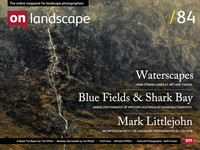Art and Timing

Hans Strand
Hans Strand is an internationally recognised photographer who has received numerous awards for his work and published three books. He lives near Stockholm in Sweden.
I recently opened a photo exhibition with my retrospective work here in Sweden. It was randomly put together and there was no overall plan, but when I saw the photographs hanging on the walls I realised that there was water present in every one of them. Everything from crashing waves, rain drops, waterfalls, creeks to flooded forests was in those images. For me, and I am sure for many other landscape photographers, water is a fantastic ingredient in our work. Theoretically it is transparent and should not make so much noise. However it is the other way around. This magical substance has infinite ways of showing itself. It can be flat without motion and work like a mirror, or in smooth motion and give the image a soft impressionistic touch or even in a classic photograph to express the power of nature. Although I have a background as an engineer, I am not so interested in writing about technical aspects of photography, but here I will make an exception. A calm reflecting water surface on a lake does not require any special photo technique, but when it comes to capturing water in motion, a right technical approach is essential. For me motion is best expressed when the water has moved just a little bit and still has kept its structure. I am therefore not a fan of images taken with "Big Stopper" filters. I find these images rely too much on technical expression. I find they are typically too much of: "let´s put a dense neutral density filter on the camera and we will see what comes out of it". The result of course come out way different from the real scene and is mainly appealing to searchers of dreamlike images - I respect that decision if that is your goal but it is not for me. As I pointed out, I prefer a more moderate level of motion blur and the methods to make such photographs is what I will describe in this article.
Rivers and torrents
When shooting rapids of a river you will get the magical combination of motion blur and structure between 1/2 second and 1/15 second, depending on the speed of the water.
The faster the water is moving the more motion blur. With modern DSLR cameras you can check the expression of motion right after your exposure. You just zoom in on your image and check the river waves. Too long a shutter speed and they tend to wash out and look like over exposed white flats without detail. Too short and you get more structure than motion. It is as simple as that. I often find shutter speeds around 1/6 of a second the best. In daylight, with a minimum of ISO100, however it can be difficult to come down to slow enough shutter speeds. Stopping down to f/22 is not a good way to do it, since the diffraction at such small apertures ruins the detail of the image. For the water itself that is not a problem, since it is going to be blurred anyway, but for other elements, like rocks in the water or trees in the background, it will be a bad alternative.

